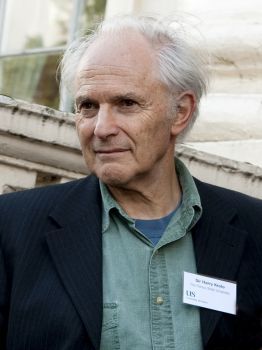Obituary: Harry Kroto
Eminent University of Sussex chemist Professor Sir Harry Kroto FRS, who became a Nobel Laureate in 1996, died on 30 April at the age of 76.
 Sir Harry Kroto
Sir Harry Kroto
Harry was born in Wisbech, Cambridgeshire, in 1939 but grew up and went to school in Bolton, where he was an all-rounder, excelling in art and sports as well as academic subjects.
Harry particularly enjoyed science and moved to the University of Sheffield to study for a chemistry degree, where he went on to undertake a PhD in molecular spectroscopy.
After periods at the National Research Council Institute of Molecular Spectroscopy in Ottawa and at Bell Labs in New York, Harry was invited to join the newly formed School of Chemistry & Molecular Sciences (MOLS) at the University of Sussex in 1967.
Here he quickly made a significant impact on the emerging field of microwave spectroscopy using the technique to study linear chains of carbon atoms suspected to exist in the dust clouds of interstellar space, and was able to definitively assign signals in the enormous amount of data from radio-telescopes.
It was this early work on carbon chains that ultimately led to his Nobel Prize winning discovery: in 1985 Harry teamed up with Rick Smalley and Robert Curl (Rice University, USA) to laser vaporise carbon in laboratory experiments designed to simulate the chemistry of stars and interstellar space.
Their experiments appeared to indicate they had made an unexpected molecular species comprising 60 carbon atoms. This was amazing. Carbon had long been known to exist as diamond or graphite, but carbon as a small molecule required completely new thinking.
This was where Harry drew on his artistic side and knowledge of graphic design: he proposed that C60 was made up of a mixture of pentagons and hexagons, a structure known in ancient times, now ubiquitous in footballs and in the architecture of Buckminster Fuller. But at first nobody could prove it, and indeed many were openly sceptical.
However, with his student Jonathan Hare, Harry examined the unpromising smudge left after an electric arc was struck between two graphite rods, and from this they were able to extract C60 with benzene as a beautiful purple solution.
Even at that time, Harry predicted that the ion of C60 should be observable in the diffuse interstellar bands in space, and famously said that the many who disagreed with him were “just wrong”. So he was delighted when John Maier’s group in Switzerland proved him correct in 2015.
Harry was always ready to acknowledge that the discovery of C60 would not have been possible without the collaboration of scientists of all backgrounds, but it was his imagination, lateral thinking, persistence, and inspiration that brought these collaborations together.
The discovery of C60, known as the “buckyball”, was closely followed by that of larger carbon cage structures and nanotubes, arguably sparking off the whole new area of nanotechnology.
Harry was one of three University of Sussex Chemistry professors who became Nobel Laureates, the others being Professor Archer Martin (1952) and Professor Sir John Cornforth (1975).
Harry was a really fun, creative, and invigorating colleague at Sussex. He featured heavily in the departmental Christmas pantomimes, playing an integral role in writing, directing and performing, basing many of his witty sketches on Fawlty Towers and Monty Python.
Harry also had a particular eye for design and designed the covers of the “Chemistry at Sussex” brochures of the 1980s, which later featured on the front cover of The MOLS Book written by John Murrell for the 50th anniversary of the University in 2011.
He was a wonderful communicator and educator, and worked relentlessly to share his passion for chemistry and bring science to a wide range of audiences. Colleagues recollect that his undergraduate lectures were so inspiring and engaging they would often elicit a spontaneous round of applause at the end!
In 1994 Harry set up the Vega Science Trust, providing an independent broadcast and archive of famous scientists describing their work.
Later, inspired by what Harry called the Goo Yoo Wiki World (Google, YouTube and Wikipedia), he set up GEOSET: Global Educational Outreach for Science, Engineering & Technology. The GEOSET philosophy was to provide outstanding teaching material located on the websites of participating academic institutions downloadable free via the Internet, particularly for teachers.
Harry realized that some of the best educators are the young and in 2014 Harry, with his wife Margaret, set up the Prize for Innovative Use of Technology in Science Learning, to be awarded for the best five-minute STEM video by school children aged 11-18 from anywhere in the world.
Harry devoted much of his time and energy visiting schools, giving public lectures and workshops which often involved building models of his famous “buckyball”, and engaging children of all ages in science. He will be sadly missed, not only by his family and friends, but also by the many who will no longer have the opportunity to share in his passion for science.
In 2005 Harry accepted a chair at the University of Florida at Tallahassee, where he continued his research in carbon chemistry and extended his world-wide educational activities, and in 2015 he retired from his Florida post and returned to his home in Sussex.
Harry was the recipient of too many awards to list and was also President of the Royal Society of Chemistry from 2002 to 2004, when he did much to lobby the government about the importance of chemistry, and science in general.
He is survived by his wife Margaret and two sons, Stephen and David.
Dr Hazel Cox and Professor Geoff Cloke, Chemistry department
